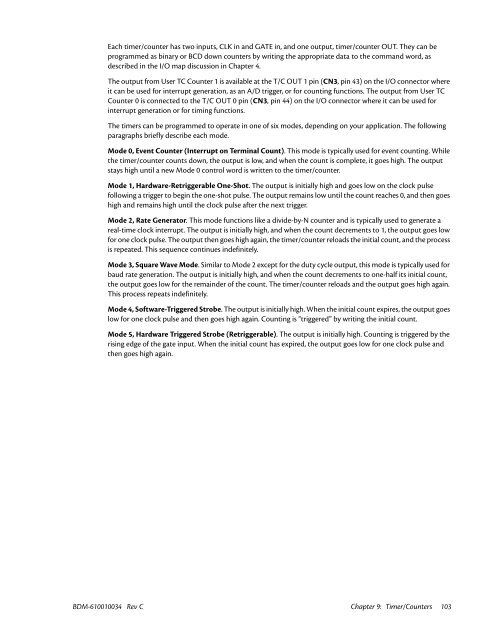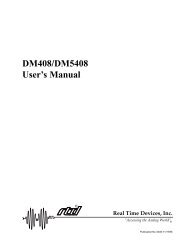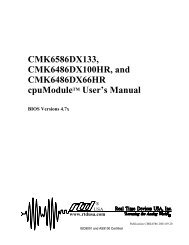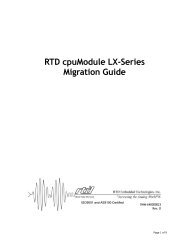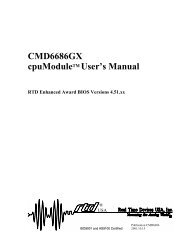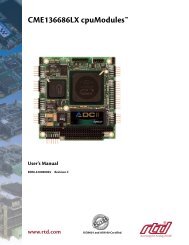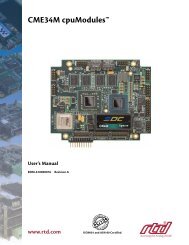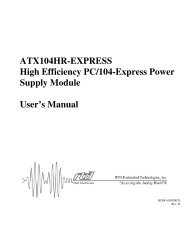Hardware Manual - RTD Embedded Technologies, Inc.
Hardware Manual - RTD Embedded Technologies, Inc.
Hardware Manual - RTD Embedded Technologies, Inc.
You also want an ePaper? Increase the reach of your titles
YUMPU automatically turns print PDFs into web optimized ePapers that Google loves.
Each timer/counter has two inputs, CLK in and GATE in, and one output, timer/counter OUT. They can be<br />
programmed as binary or BCD down counters by writing the appropriate data to the command word, as<br />
described in the I/O map discussion in Chapter 4.<br />
The output from User TC Counter 1 is available at the T/C OUT 1 pin (CN3, pin 43) on the I/O connector where<br />
it can be used for interrupt generation, as an A/D trigger, or for counting functions. The output from User TC<br />
Counter 0 is connected to the T/C OUT 0 pin (CN3, pin 44) on the I/O connector where it can be used for<br />
interrupt generation or for timing functions.<br />
The timers can be programmed to operate in one of six modes, depending on your application. The following<br />
paragraphs briefly describe each mode.<br />
Mode 0, Event Counter (Interrupt on Terminal Count). This mode is typically used for event counting. While<br />
the timer/counter counts down, the output is low, and when the count is complete, it goes high. The output<br />
stays high until a new Mode 0 control word is written to the timer/counter.<br />
Mode 1, <strong>Hardware</strong>-Retriggerable One-Shot. The output is initially high and goes low on the clock pulse<br />
following a trigger to begin the one-shot pulse. The output remains low until the count reaches 0, and then goes<br />
high and remains high until the clock pulse after the next trigger.<br />
Mode 2, Rate Generator. This mode functions like a divide-by-N counter and is typically used to generate a<br />
real-time clock interrupt. The output is initially high, and when the count decrements to 1, the output goes low<br />
for one clock pulse. The output then goes high again, the timer/counter reloads the initial count, and the process<br />
is repeated. This sequence continues indefinitely.<br />
Mode 3, Square Wave Mode. Similar to Mode 2 except for the duty cycle output, this mode is typically used for<br />
baud rate generation. The output is initially high, and when the count decrements to one-half its initial count,<br />
the output goes low for the remainder of the count. The timer/counter reloads and the output goes high again.<br />
This process repeats indefinitely.<br />
Mode 4, Software-Triggered Strobe. The output is initially high. When the initial count expires, the output goes<br />
low for one clock pulse and then goes high again. Counting is “triggered” by writing the initial count.<br />
Mode 5, <strong>Hardware</strong> Triggered Strobe (Retriggerable). The output is initially high. Counting is triggered by the<br />
rising edge of the gate input. When the initial count has expired, the output goes low for one clock pulse and<br />
then goes high again.<br />
BDM-610010034 Rev C Chapter 9: Timer/Counters 103


